Hibiscus rosa-sinensis
Hibiscus rosa-sinensis | |
|---|---|
 | |
Hibiscus rosa-sinensis 'Brilliant' | |
Scientific classification | |
| Kingdom: | Plantae |
Clade: | Angiosperms |
Clade: | Eudicots |
Clade: | Rosids |
| Order: | Malvales |
| Family: | Malvaceae |
| Genus: | Hibiscus |
| Species: | H. rosa-sinensis |
Binomial name | |
Hibiscus rosa-sinensis L. | |
Synonyms[1] | |
| |
Hibiscus rosa-sinensis, known colloquially as Chinese hibiscus,[2]China rose,[2]Hawaiian hibiscus,[2], rose mallow[3] and shoeblackplant,[4] is a species of tropical hibiscus, a flowering plant in the Hibisceae tribe of the family Malvaceae, native to East Asia.
@media all and (max-width:720px){.mw-parser-output .tmulti>.thumbinner{width:100%!important;max-width:none!important}.mw-parser-output .tmulti .tsingle{float:none!important;max-width:none!important;width:100%!important;text-align:center}}

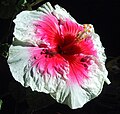


Contents
1 Nomenclature
2 Vegetative characters
3 Floral characters
3.1 Floral formula
4 Ecology
5 Genetics
6 Uses
7 Cultivation
8 National symbol
9 Gallery
10 See also
11 Footnotes
12 References
13 External links
Nomenclature
Hibiscus rosa-sinensis was named in 1753 by Carl Linnaeus in his Species Plantarum.[5] The Latin term rosa-sinensis literally means "rose of China", though it is not closely related to the true roses.[6]
== Description == hibiscus is also known as shoeflower
Hibiscus rosa-sinensis is a bushy, evergreen shrub or small tree growing 2.5–5 m (8–16 ft) tall and 1.5–3 m (5–10 ft) wide, with glossy leaves and solitary, brilliant red flowers in summer and autumn. The 5-petaled flowers are 10 cm (4 in) in diameter, with prominent orange-tipped red anthers.[7]

China Rose
Vegetative characters
The root is a branched tap root. The stem is aerial, erect, green, cylindrical and branched. The leaf is simple, with alternate phyllotaxy and is petiolate. The leaf shape is ovate, the tip is acute and margin is serrated. Venation is unicostate reticulate. (Venation is branched or divergent.) Free lateral stipules are present.
Floral characters
This section may be too technical for most readers to understand. Please help improve it to make it understandable to non-experts, without removing the technical details. (September 2016) (Learn how and when to remove this template message) |
The flower is
- Complete (bisexual),
- Actinomorphic,
- Bracteate or ebracteate,
- Bracteolate or ebracteolate,
- Pedicellate,
- Dichlamydeous,
- Regular,
- Pentamerous,
- Hypogynous - with superior Ovary, and
- Solitary.[citation needed]
Epicalyx are present, valvate aestivation, free. Calyx are gamosepalous, valvate, sepaloid. Carolla are polypetalous, twisted, peetaloid. Indefinite stamens, monoadulphous. Gyanoecium pentacarpellary, ovary superior, placentation axile, syncarpous.
It can bloom all year round
Floral formula
Br,Brl,☿,K5,[C5 A∞],G5-Superior Hypogynous with twisted Astevation

Hibiscus flower displaying the Petals, Style, Stigma and Anthers prominently. Sepals of the Calyx (in the flower) are hidden behind the petals while they can seen nearby of a fallen flower.
Ecology
Despite its size and red hues, which are attractive to nectarivore birds, it is not visited regularly by hummingbirds when grown in the Neotropics. Generalist species, like the sapphire-spangled emerald, Amazilia lactea, or long-billed species, like the stripe-breasted starthroat, Heliomaster squamosus, are occasionally seen to visit it, however.[8] In the subtropical and temperate Americas, hummingbirds are regularly attracted to it.[9]
The endangered Papilio homerus butterfly, the largest in the western hemisphere, is known to feed on the nectar of the Hibiscus.[10]

The stamens of the flower are partly fused into a cylinder that surrounds the style
Genetics
Hibiscus rosa-sinensis is one of many plant species with a genetic characteristic known as polyploidy, in which there are more than two complete sets of chromosomes, unlike most other species.[11] A side effect of polyploidy is a condition where the phenotype of the offspring may be quite different from the parent, or indeed any ancestor, essentially allowing possibly random expression of all (or any) of the characteristics of all the generations that have gone before. Because of this characteristic, H. rosa-sinensis has become popular with hobbyists who cross and recross varieties, creating new named varieties and holding competitions to exhibit and judge the many resulting new seedlings and often strikingly unique flowers.[citation needed]
Uses

A white cultivar
The flowers of Hibiscus rosa-sinensis are edible and are used in salads in the Pacific Islands.[citation needed] The flower is additionally used in hair care as a preparation. It is also used to shine shoes in certain parts of India. It can also be used as a pH indicator. When used, the flower turns acidic solutions to a dark pink or magenta color and basic solutions to green. It is also used for the worship of Devi, and the red variety is especially prominent, having an important part in tantra. In Indonesia, these flowers are called "kembang sepatu", which literally means "shoe flower". In several countries the flowers are dried to use in a beverage, usually tea.
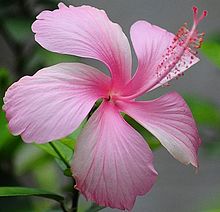
Pink Hibiscus in South India
Hibiscus rosa-sinensis is considered to have a number of medical uses in Chinese herbology.[12] It may have some potential in cosmetic skin care; for example, an extract from the flowers of Hibiscus rosa-sinensis has been shown to function as an anti-solar agent by absorbing ultraviolet radiation.[13]
Cultivation
It is widely grown as an ornamental plant throughout the tropics and subtropics. As it does not tolerate temperatures below 10 °C (50 °F), in temperate regions it is best grown under glass. However, plants in containers may be placed outside during the summer months or moved into shelter during the winter months.[7][14]
Numerous varieties, cultivars, and hybrids are available, with flower colors ranging from white through yellow and orange to scarlet and shades of pink, with both single and double sets of petals. The cultivar 'Cooperi' has gained the Royal Horticultural Society's Award of Garden Merit.[3][15]
National symbol

A dark pink cultivar
Hibiscus rosa-sinensis is the national flower of Malaysia, called Bunga Raya in Malay. Introduced into the Malay Peninsula in the 12th century, it was nominated as the national flower in the year 1958 by the Ministry of Agriculture amongst a few other flowers, namely ylang ylang, jasmine, lotus, rose, magnolia, and medlar. On 28 July 1960, it was declared by the government of Malaysia that Hibiscus rosa-sinensis would be the national flower.
The word bunga in Malay means "flower", while raya in Malay means "celebratory" or "grand". The Hibiscus rosa-sinensis is literally known as the "celebratory flower" in Malay. The red of the petals symbolizes the courage, life, and rapid growth of the Malaysian, and the five petals represent the five Rukun Negara of Malaysia. The flower can be found imprinted on the notes and coins of the Malaysian ringgit.
== Cultural references
- In India,hibiscus(rosa-sinensis)flower is also used for pray of goddess.
- In March 1987 DPR Korea issued a postage stamp depicting Hibiscus rosa-sinensis.
- On 7 October 2012, Sri Lanka too, issued a stamp set of four and one of it carried a Hibiscus rosa-sinensis flower.
Gallery
Cultivars with flowers of many colours are used as ornamental plants. Some are double or have differently shaped petals.
See also
- Hibiscus tea
- Hibiscus
Footnotes
^ "The Plant List: A Working List of All Plant Species". Retrieved June 13, 2015..mw-parser-output cite.citation{font-style:inherit}.mw-parser-output q{quotes:"""""""'""'"}.mw-parser-output code.cs1-code{color:inherit;background:inherit;border:inherit;padding:inherit}.mw-parser-output .cs1-lock-free a{background:url("//upload.wikimedia.org/wikipedia/commons/thumb/6/65/Lock-green.svg/9px-Lock-green.svg.png")no-repeat;background-position:right .1em center}.mw-parser-output .cs1-lock-limited a,.mw-parser-output .cs1-lock-registration a{background:url("//upload.wikimedia.org/wikipedia/commons/thumb/d/d6/Lock-gray-alt-2.svg/9px-Lock-gray-alt-2.svg.png")no-repeat;background-position:right .1em center}.mw-parser-output .cs1-lock-subscription a{background:url("//upload.wikimedia.org/wikipedia/commons/thumb/a/aa/Lock-red-alt-2.svg/9px-Lock-red-alt-2.svg.png")no-repeat;background-position:right .1em center}.mw-parser-output .cs1-subscription,.mw-parser-output .cs1-registration{color:#555}.mw-parser-output .cs1-subscription span,.mw-parser-output .cs1-registration span{border-bottom:1px dotted;cursor:help}.mw-parser-output .cs1-hidden-error{display:none;font-size:100%}.mw-parser-output .cs1-visible-error{font-size:100%}.mw-parser-output .cs1-subscription,.mw-parser-output .cs1-registration,.mw-parser-output .cs1-format{font-size:95%}.mw-parser-output .cs1-kern-left,.mw-parser-output .cs1-kern-wl-left{padding-left:0.2em}.mw-parser-output .cs1-kern-right,.mw-parser-output .cs1-kern-wl-right{padding-right:0.2em}
^ abc "Hibiscus rosa-sinensis". Germplasm Resources Information Network (GRIN). Agricultural Research Service (ARS), United States Department of Agriculture (USDA). Retrieved 2 August 2014.
^ ab "RHS Plant Selector - Hibiscus rosa-sinensis 'Cooperi'".
^ "Hibiscus rosa-sinensis - Chinese Hibiscus, Shoeblackplant, Tropical Hibiscus, Red Hibiscus - Hawaiian Plants and Tropical Flowers". wildlifeofhawaii.com.
^ Linnaeus, Carl. Species Plantarum. 2. p. 694.
^ Harrison, Lorraine (2012). RHS Latin for gardeners. United Kingdom: Mitchell Beazley. p. 224. ISBN 9781845337315.
^ ab RHS A-Z encyclopedia of garden plants. United Kingdom: Dorling Kindersley. 2008. p. 1136. ISBN 1405332964.
^ Baza Mendonça & dos Anjos (2005)
^ "Hibiscus rosa-sinensis". tropicalplantbook.com.
^ Lehnert, Matthew S.; Kramer, Valerie R.; Rawlins, John E.; Verdecia, Vanessa; Daniels, Jaret C. (2017-07-10). "Jamaica's Critically Endangered Butterfly: A Review of the Biology and Conservation Status of the Homerus Swallowtail (Papilio (Pterourus) homerus Fabricius)". Insects. 8 (3): 68. doi:10.3390/insects8030068.
^ "IPCN Chromosome Reports".
^ Plants for a Future: Hibiscus rosa-sinensis.
^ Nevade Sidram A., Sachin G. Lokapure and N.V. Kalyane. 2011. Study on anti-solar activity of ehanolic extract of flower of Hibiscus rosa-sinensis Linn. Research Journal of Pharmacy and Technology 4(3): 472-473. Archived 24 May 2013 at the Wayback Machine.
^ Gast, Ross H. "The Cultural Potential of the Hibiscus to Southern California". The Arboretum - arboretum.org. Archived from the original on 25 December 2010. Retrieved 29 March 2009.
^ "AGM Plants - Ornamental" (PDF). Royal Horticultural Society. July 2017. p. 48. Retrieved 3 March 2018.
References
- Hibiscus rosa-sinensis(India)(http://in.pinterest.com/pin/
.mw-parser-output .smallcaps{font-variant:small-caps}
Baza Mendonça, Luciana & dos Anjos, Luiz (2005): Beija-flores (Aves, Trochilidae) e seus recursos florais em uma área urbana do Sul do Brasil [Hummingbirds (Aves, Trochilidae) and their flowers in an urban area of southern Brazil]. [Portuguese with English abstract] Revista Brasileira de Zoologia 22(1): 51–59. doi:10.1590/S0101-81752005000100007 PDF fulltext
"Hibiscus rosa-sinensis". Integrated Taxonomic Information System.
- The International Hibiscus Society ([1])
- The American Hibiscus Society ([2]),([3])
- The Australian Hibiscus Society Inc. ([4])
- Hibiscusmania (France) ([5])
- Hibiscusfreunde (Germany) ([6])
- Hibiscus Forrest (Hungary) ([7])
- Hibiscus rosa-sinensis (Chinese) (http://baike.baidu.com/view/181048.htm)
External links
| Wikimedia Commons has media related to Hibiscus rosa-sinensis. |



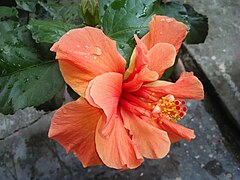


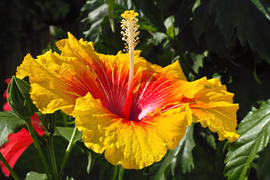





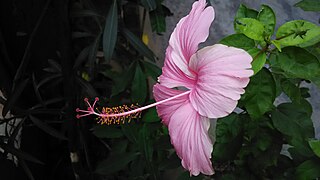






Comments
Post a Comment